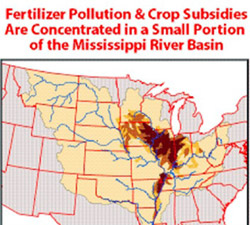Stop the Farm Bill
In order to save the family farm, bring down skyrocketing health costs, slow down immigration of Mexican farmers who are being driven off their land, and save the Gulf of Mexico, we must stop the Farm Bill, passed by the House and now up in the US Senate.
 There may be no better sign of the changing debate over the nation’s farm subsidies: A Midwestern governor running for president calls for cuts in a system that has steered hundreds of millions of dollars a year to his state.
There may be no better sign of the changing debate over the nation’s farm subsidies: A Midwestern governor running for president calls for cuts in a system that has steered hundreds of millions of dollars a year to his state.
“I didn’t get much of a reaction from farmers,” said Iowa Gov. Tom Vilsack (D), “because deep down most of them know the system needs to be changed.” (Source: Powerful Interests Ally to Restructure Agriculture Subsidies, Washington Post.)
Lance Armstrong serves on the President’s Cancer Panel, which released a report this year concluding that processed forms of corn and soybeans – heavily subsidized commodity crops- are known contributors to obesity and chronic diseases, including cancer. The upcoming reauthorization of the Farm Security and Rural Investment Act (the Farm Bill) provides an opportunity that must not be missed to strongly increase support for fruit and vegetable farmers.
Over 300 Doctors, Health Professionals Call For Healthy Farm Bill
“The Farm Bill is fundamentally a public health bill,” said Dr. Benjamin of the American Public Health Association. “Its long reach affects the food security of our nation and, in turn, our health.”
The letter, sent to Chairs and Ranking Minority Members on the House and Senate Agriculture Committees, targets policies in previous Farm Bills that have helped make the calorie-dense foods Americans already over-consume – namely cheap starches and highly processed foods made from added sweeteners and oils derived from corn and soybeans – some of the cheapest to buy.
“Our communities are flooded with cheap, unhealthy foods that ultimately are helping drive healthcare costs through the roof,” said Dr. David Wallinga, director of the Food and Health Program at the Institute for Agriculture and Trade Policy. The Farm Bill works at cross purposes with USDA dietary guidelines. (Source: Over 300 Doctors, Health Professionals Call For Healthy Farm Bill, FarmbillPrimer.org.)
Instead of moving resources to small farmers, the (farm) bill protects multi-millionaire farmers. http://www.bread.org/take-action/recent-developments-on-seeds-of-change.html
Our current Farm Bill is OUT OF BALANCE. It has led to a promotion of unhealthy foods, environmental contamination, resource depletion, and a startling decline in small and medium-sized family farms. http://www.sustainablefoodcenter.org/farmbill2007.html
The Center for Disease Control recommends five cups a day of fruits and vegetables to maintain health. http://www.cdc.gov/nccdphp/dnpa/5aday/index.htm
 But government farm policies make junk food cheaper every year, and fruits and vegetables more expensive, contributing to skyrocketing medical costs.
But government farm policies make junk food cheaper every year, and fruits and vegetables more expensive, contributing to skyrocketing medical costs.
It is one of the toughest environmental problems facing America. For over 20 years, scientists have documented the appearance of a summertime “Dead Zone” that all but obliterates marine life in what is arguably the nation’s most important fishery, the Gulf of Mexico.
We found that the vast majority of fertilizer pollution comes from a relatively small area of heavily subsidized cropland along the Mississippi and its tributaries where taxpayer funded commodity spending overwhelms water quality related conservation spending by more than 500 to 1.
Dead in the Water: News Release – Farm Subsidy Reform Key to Restoring Gulf of Mexico “Dead Zone”
United Nations Environment Programsays reducing nitrogen discharges can restore the seas to health: http://news.bbc.co.uk/2/hi/science/nature/3577711.stm
Massive oxygen-starved zones are developing along the world’s coasts
There’s no mystery as to what triggers this annual hypoxic zone, as the oxygen-starved region is formally termed. Into the Gulf of Mexico, the Mississippi River deposits water that is heavily enriched with plant nutrients, principally nitrate. This pollutant fertilizes the abundant growth of tiny, floating algae. As blooms of the algae go through their natural life cycles and die, they fall to the bottom and create a feast for bacteria. Growing in unnatural abundance, the bacteria use up most of the oxygen from the bottom water.
Caused almost exclusively by human activities, coastal dead zones are becoming increasingly common and recurrent, observes Robert J. Diaz of the Virginia Institute of Marine Sciences in Gloucester Point. His group finds that the number of major dead zones has been roughly doubling every decade since the 1960s.
On March 29, the United Nations Environment Program issued its first Global Environment Outlook Year Book, a volume highlighting issues requiring urgent attention. The report drew notice to the increase in major coastal dead zones. After examining unpublished data by Diaz’ team, the U.N. body concluded that there are some 150 recurring and permanent dead zones in seas worldwide.
Over the past century, “overfishing was the leading environmental issue affecting our seas,” Diaz says. “In the new millennium, it’s going to be oxygen.”
http://www.sciencenews.org/articles/20040605/bob9.asp
Comments (3)

kt1nbo
ir6l9m
u3vyur